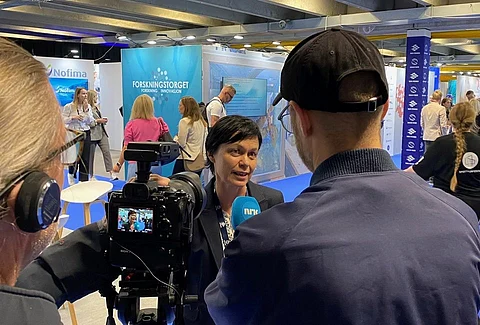

Ingunn Sommerset, Director of Fish Health and Welfare at the Veterinary Institute, pictured speaking with reporters at Aqua Nor 2025.
Photo: Tom Haavardstun, Norwegian Veterinary Institute (Veterinærinstituttet).
The Norwegian Veterinary Institute (Veterinærinstituttet) has reported that mortality among farmed salmon in the seawater phase has declined slightly in the first half of 2025 compared with last year.
Announcing the findings during the Aqua Nor 2025 conference in Trondheim this week, Ingunn Sommerset, Director of Fish Health and Welfare at the Veterinary Institute, said that fish mortality was calculated at 7.3% for the first six months of 2025, compared with 8.8% for the same period in 2024. For the whole of last year, the accumulated mortality rate ended at 15.4%, down from 16.7% the previous year.
However, Sommerset warned, mortality figures for six months cannot be directly compared with full-year results, as losses increase with each additional month in the calculation.
Although the reported rate for the first half of 2025 is lower than last year, the Veterinary Institute stressed that the figures are based on preliminary data and should be treated with caution. Some regions have recorded large numbers of fish in the category “other”, which is not included in the mortality calculation. The institute added that delayed registrations may still be reported for up to six months.
“It is therefore not possible to conclude that the situation is different from last year without more information and data,” the institute said.
According to the institute, the most notable change has been observed in Western Norway, where fish mortality has previously been significantly higher than in other parts of the country.
“There are still serious health and welfare challenges in the aquaculture industry, but there are also positive developments. If we look at Western Norway, mortality has previously been far higher than in the rest of the country. From last summer and into the first months of 2025, the levels there are closer to typical national values,” Sommerset said.
However, despite these improvements, the institute reported that 26.3 million dead fish have been registered so far in 2025. The number of fish recorded under the “other” loss category rose from just over 5 million in 2023 to almost 10 million in 2024, with 5.8 million already registered in the first half of this year. The cause of the increase is not known, the Institute said.
The figures are based on monthly reports submitted by farmers to the Directorate of Fisheries. The calculation method adjusts for changes in the number of fish at sea over time, and the institute says it provides a useful indicator of fish welfare.
In 2023 Norway recorded its highest-ever mortality rate of sea-phase salmon, reaching 62.8 million, and prompting calls for serious action on fish health and welfare.
More recently, veterinary associations and fish health experts from across Norway have called for stricter regulation on mortality and proposed incentivising better fish welfare by permitting only the 25% top-performing operators within each production area to grow their operations.
As part of its reform of aqauculture regulation voted in by the Storting earlier this year, the Norwegian government is aiming to cut fish mortality to 5%, bringing in penalties for high mortality while rewarding welfare-focused operations.
